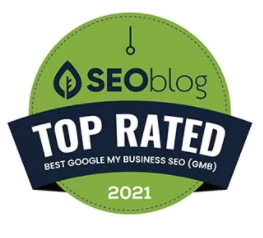You know there’s more to advertising your small business than word of mouth and referrals. But with so many different types of online advertising to choose from, including on search engines like Google and Bing, not to mention social networks like Facebook, or video giant YouTube, it’s easy to get lost.
How do you even get started, let alone avoid making costly mistakes when you try to do it yourself? Keep reading to discover 7 of the most common PPC blunders and search ads mistakes, and learn how to avoid them.
Are you guilty of making any of these 7 digital advertising mistakes?
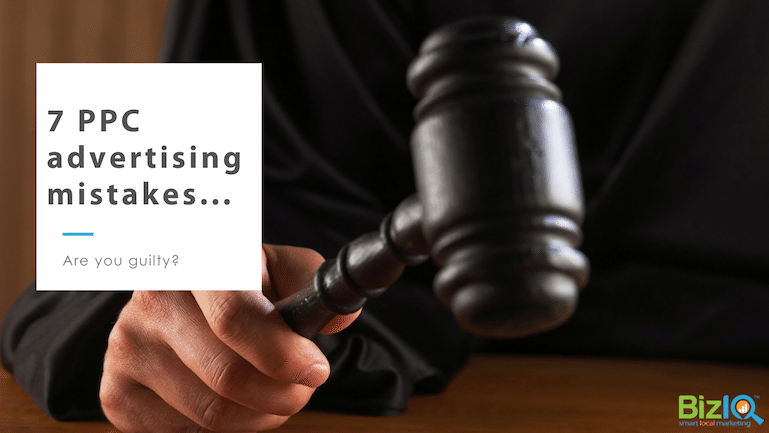
7 common search ads and pay per click mistakes that we’ve come across include:
1. Confusing SEO with SEM
2. Not knowing the difference between various types of digital advertising campaigns
3. No advertising strategy
4. Tracking and analyzing the wrong metrics
5. Trusting Google to manage your PPC campaigns automatically
6. Not setting up conversion goals based on revenue goals
7. Bad ad copy or low-quality landing pages
Below we take a look at each of the 7 PPC and paid media errors small businesses make and provide you with actionable tips on what you can do instead. Plus, we provide you with bonus content on some of the most vital PPC management concepts. And now, on to the 7 mistakes!
1. Confusing SEO with SEM
To reduce online marketing mistakes, it’s important to understand the difference between the roles of SEO and SEM.
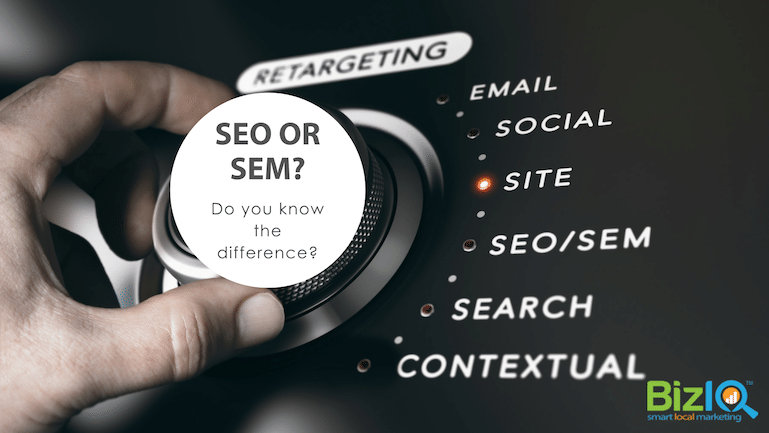
However, many professionals often confuse the two concepts.
SEO, short for Search Engine Optimization, is designed to optimize online content to get better rankings on the Search Engine Results Pages (SERP). Whereas SEM, short for Search Engine Marketing, was originally more extensive and inclusive of SEO, but now gets used to describe search advertising exclusively.
Pro Tip: SEO and SEM strategies complement each other.
Local companies should use search engine optimization to improve their rankings in organic search results while employing search engine marketing tactics like pay-per-click ads on Google to get their business in front of more customers quickly.
2. Not knowing the Difference Between Display, Social, and Search Ads Campaigns
There are many search advertising options and platforms available.
When it comes to all the choices you have in advertising platforms and campaign, the field is enormous. However, understanding the differences between campaign types and when to use each one will help you take your small business advertising to the next level, increase revenue, and bring in more customers.
Some of the most common digital advertising platforms are:
⯁ Google Ads
⯁ Google Local Services Ads – Formally Google Home Service Ads
⯁ Facebook Ads

Within each platform, there are various campaign types. For example, Google Ads has the following:
⯁ Search Network campaigns
⯁ Discovery campaigns
⯁ Display Network campaigns
⯁ Shopping campaigns
⯁ Video campaigns
⯁ App campaigns
What are search ads?
Search ads are paid advertisements that appear in the search results. They’re usually marked as an ad. For example, Google marks its search ads with the word “Ad” surrounded by a green square.
What is Pay Per Click advertising?
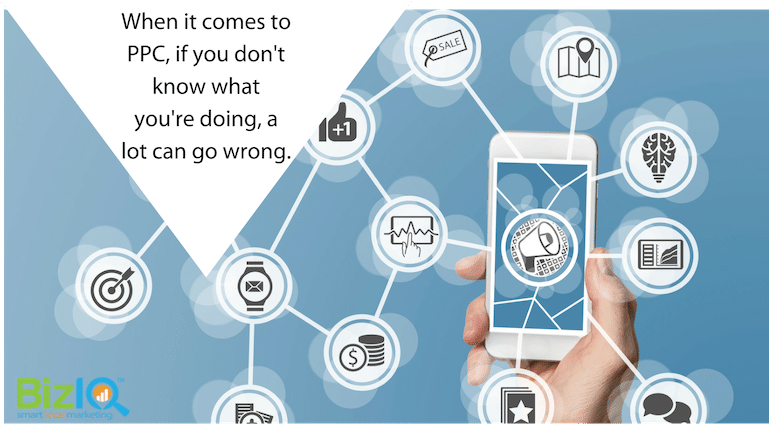
PPC (Pay Per Click) is the most popular form of search engine advertising. Unlike organic search results, PPC ads aren’t free. Instead, you pay a small fee for your PPC ads whenever someone clicks on one of them.
Just like SEO, PPC and most other forms of search ads involve keywords. However, with paid online advertising, where your ads appear in search results has to do with a number of factors including landing page quality, and keyword bidding.
PPC advertising mistakes take place when advertisers do not include the following in their marketing efforts:
⯁ Testing
⯁ Setting up systems that detect click fraud
⯁ Setting up GEO targeting
⯁ Making sure landing pages are relevant
⯁ Monitoring domain names that provide traffic with high bounce rates
⯁ Forgetting about negative keywords when creating keyword lists
What is Google Ads?
Google Ads – formally Google Adwords, is an advertising system that allows digital marketers to bid on keywords, so specific ads appear in Google search results, on Google Discover, on YouTube, and on other websites that are in the Google Display Network.
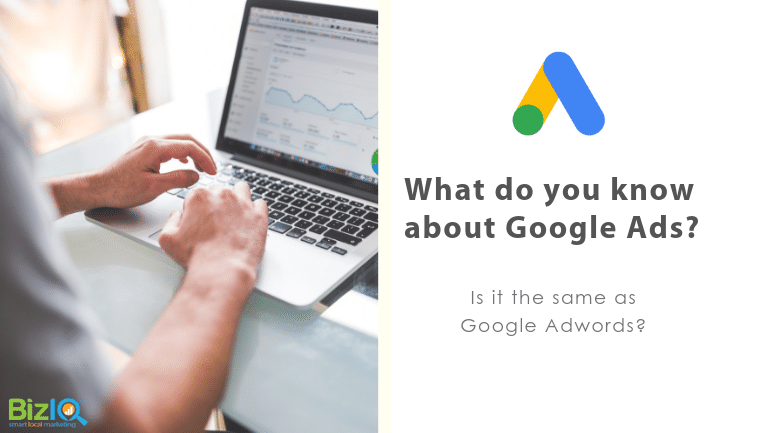
What are the common Google Ads mistakes?
Google Ads campaign mistakes are relatively common and involve:
⯁ Not having enough ad variations
⯁ A high amount of broad match keywords
⯁ Not fully maximizing the use of extensions
⯁ Poor follow up, so red flags are monitored to identify:
— Exceptionally high CPC‘s
— Keywords containing low CTRs
— Irrelevant queries that appear in the same search term reports
What are display ads?
Display ads are designed to entice users of a website, social media network, app, or other online media to perform a specific action. They appear on websites, YouTube, mobile apps, social media, email sites. The Google Display Network and Facebook are two of the largest display advertising platforms.
Display ads can be text-based, but usually, involve the use of visuals like videos or images that are displayed online. Typically a person who clicks on a display ad is taken to a landing page where they are hopefully convinced to take another action, which often involves something like purchasing a product or agreeing to a sales demonstration. This type of ad is also used for retargeting customers who have visited a website before.
The most common display advertising mistakes consist of:
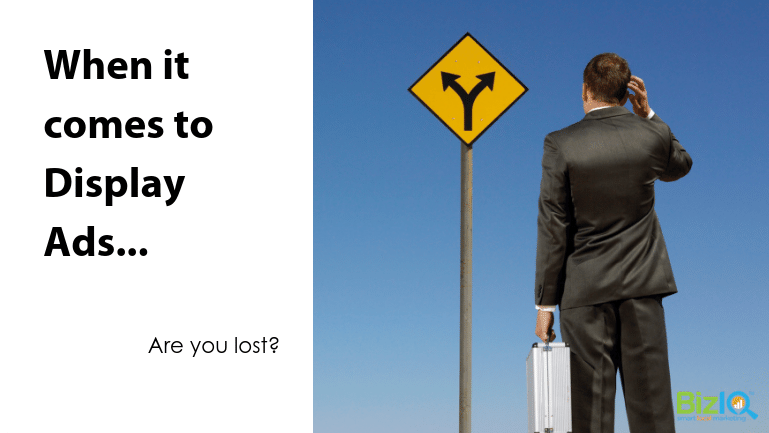
⯁ Focusing more on CTR than ROI
⯁ Misleading CTAs
⯁ Lack of A/B split testing,
⯁ Advertising on the wrong website
⯁ Not running mobile-friendly ads
⯁ Neglecting to run display ads on social media platforms
What are Local Services Ads?
Google Local Services – formerly Google Home Services, is an advertising program aimed at local service area businesses like plumbers, locksmiths, handymen, auto mechanics, and pet groomers.
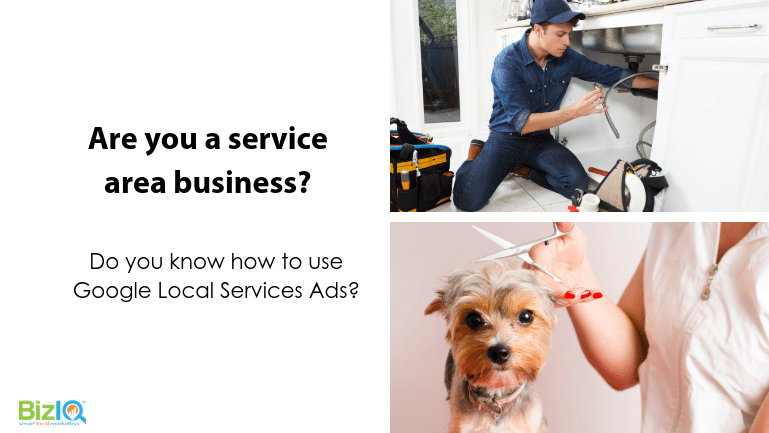
The ads appear in Google local search results above any PPC ads and above the local pack and other organic results. Unlike PPC ads, rather than paying per ad click, businesses only pay per lead. Additionally, Local Services ads are job category based, not keyword based.
The major mistake concerning Local Services ads is thinking Local Service ads, Google ads, and Google My Business listings are all the same product. Local Services doesn’t use the Google Ads dashboard. It has its own.
However, a Google Ads account is required. You do not have to use GMB to run Local Services ads, but having a verified Google listing can help improve your Local Services ads.
What are Google Discovery Ads?
Google Discover is another form of mobile search that instead of keywords, uses people’s interests to display content. It’s not exactly a new Google concept. Instead, it’s an expansion and rebranding of what used to be called Google Feed, and before that was Google Now.
Google Discovery Ad campaigns mean you can target specific audiences based on their interests and create visual ads that show up on Google Discover, the YouTube home feed, and Gmail.
Like traditional search campaigns, Google discovery ads are charged per click and use the Google Ads platform to set up.
What are Facebook Ads?
Facebook Ads are ads that appear in the Facebook newsfeed and in the right-hand column that appears only on the desktop version of the social media platform. The target audience of the ads is based on things like demographics, interests, and the specific actions a user takes on Facebook. Facebook has some of the most sophisticated targeting available, which is why it’s such a powerful and popular online advertising platform.

Pro Tip: Familiarize yourself with campaign types and each advertising platform relevant to your business.
Again, when it comes to learning everything about all the Paid Media advertising options available from Google to Facebook, it can get overwhelming. However, by understanding the key differences between each campaign, you will know what to track and which types are best for your business.
3. No Advertising Strategy
Many organizations do not have clear key performance indicators (KPI’s) when it comes to developing a digital advertising strategy. As a result, they fail to define their audience or maintain adequate knowledge about how to create effective PPC ads that yield results.
Without clear, measurable advertising goals, how do you know what’s working and what you need to change?
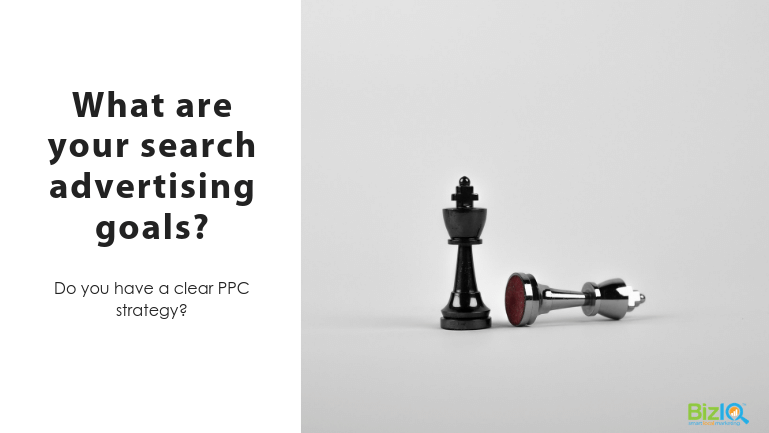
Pro Tip: Define your goals and use the right strategies to achieve them.
These include strategies related to the following:
⯁ Keywords
⯁ Ad Copy
⯁ Landing Pages
⯁ Target Audience
⯁ Bidding
⯁ Ad Extensions.
4. Tracking and Analyzing the Wrong Data
Analyzing the wrong data and monitoring incorrect metrics, as well as failing to familiarize yourself with the most fundamental aspects of Google Analytics, will only cause headaches and money. As a result, many companies wind up tracking so-called vanity metrics that reveal nothing about how your ad campaigns are performing, not to mention their return on investment (ROI).
Knowing which metrics to track and which are most important will depend on your goals, the type of campaign you’re running, and which ad extensions you’re using. There are some metrics that just about everyone should track, while there are others that won’t be relevant to certain goals.
Pro Tip: Learn the differences between the most common metrics
This topic is vast and something we’re cover at length in a future blog post, but learning the following parameters will help you better understand how to set goals, and how to decipher any reports your online advertising agency or consultants send you.
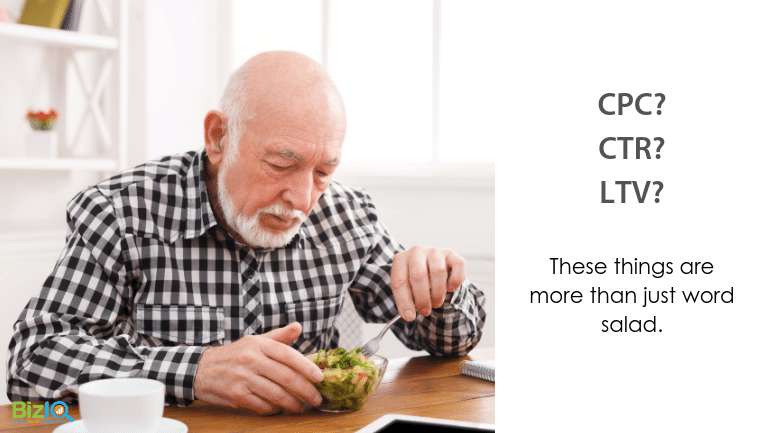
Common online advertising metrics include:
⯁ Cost Per Conversion (CPC)
A conversion can be something like filling out a form, becoming a lead, scheduling a demo, calling your business, or making a purchase. Your CPC = the total cost of your ad campaign divided by the total number of conversions.
⯁ Cost Per Acquisition (CPA)
It’s a common error to mix up CPC and CPA, but the cost per acquisition is an average that’s determined by dividing the total cost per click by your total number of conversions.
⯁ Cost Per Click (also abbreviated as CPC)
So, if you’re confused by the difference between CPC and CPC, you’re not alone. Because it is confusing to use the same acronym for two different things. Cost Per Click is just like it sounds. It’s the amount you’re charged per click on your ad.
⯁ Lifetime Value (LTV)
The lifetime value is the value of a customer over time. Measure LTV by finding the sum of the average transaction, their purchase frequency in a year, and an estimate of the length in years the person will remain a customer.
⯁ Return on Advertising Spend (ROAS)
To gain an understanding of the exact yield you’re getting from a specific ad campaign, divide the total campaign revenue by the total cost of the campaign.
⯁ Click Through Rate (CTR)
The metric is a percentage of people who click on your ad and then “click through” to the landing page.
5. Trusting Google to Automatically Manage Your PPC Campaigns
At the beginning of 2019, Google completed a massive rebranding of all of its online advertising products, including integrating Adwords Express and Adwords under the umbrella of Google Ads. Adwords expressed became a new and improved feature called Smart Campaigns in which a business allows Google to automate key aspects of an ad campaign.
Pro Tip: Don’t trust Google and machine learning to manage every aspect of your online advertising.
Rather than trusting Google to manage PPC campaigns automatically, advertisers can address this issue by developing proper management systems and reports that allow them to make the best advertising decisions on their own, based on what’s best for the campaign goals, or higher an agency to help them.
6. Not Setting Up Conversion Goals Based on Revenue Goals
Advertisers that do not set up conversion goals based on their revenue goals will have a hard time determining their marketing budget as well as figuring out how much traffic is needed to generate enough leads that convert.
Furthermore, not tying your marketing and advertising KPI’s to your business goals can have you tracking incorrect metrics and making the mistake of canceling all investment in online advertising because you confuse your lack of understanding of Paid Media advertising with the success or failure of your PPC campaigns.
Pro Tip: Determine your business goals and then set your conversion goals and ROAS accordingly.
7. Poor Ad Copy and Low-Quality Landing Pages
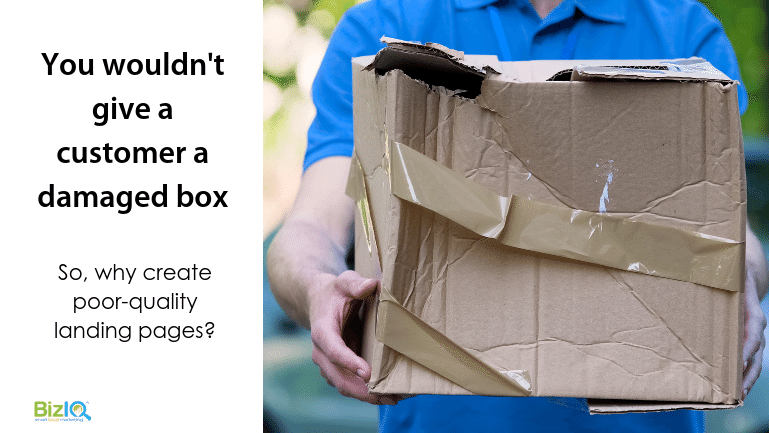
Poorly written ad copy and low-quality landing pages do not provide the kind of trust and credibility that is needed to secure sales. Plus, when it comes to search ads, a lower quality score for your landing page might result in your ad not appearing in search results at all, let alone on page 1. Furthermore, the quality score also affects your CPA. A lower score could cost you more.
Pro Tip: Create better ads and landing pages or hire someone who can.
Here are a few steps you can take to improve the quality score of your Google PPC ads:
⯁ Use high-quality keywords
⯁ Create ads and landing pages relevant to your keywords
⯁ Pay attention to the user experience of your landing page
⯁ Group ads by keywords
Effective Digital Advertising takes a lot of work
There are so many moving parts that search ads and other types of digital advertising can be tough to manage on your own. However, whether you decide to go it alone, or opt to hire an agency, it’s crucial you understand at least the basics.
Educate yourself enough to understand the choices available and which metrics to track. Set goals and tie them back to your business goals. Know the difference between a low-quality ad and a good one, and don’t make the mistake of trusting Google to manage everything for you.
We made it to the end
Wow! We’ve covered a lot of territory in one article. But hopefully, you now understand that continuing to make search ad mistakes and blunders can become very costly. Now that you have a better understanding of the pitfalls and traps, so many other small businesses fall into, you’ll be able to avoid them.
Need more PPC help?
If you’re looking for more information on taking your search advertising to the next level, make sure to read the 5 online advertising best practices.
If you’re just getting started and are confused about search ads and how they work, please don’t leave your ad campaigns to chance. Contact us today to learn how we can help you manage your PPC.



